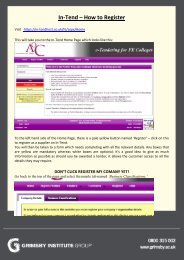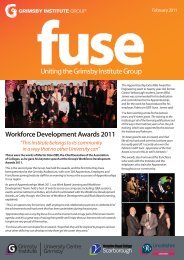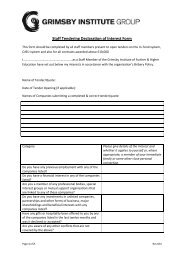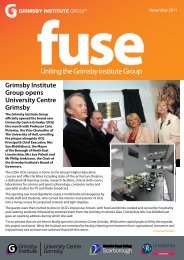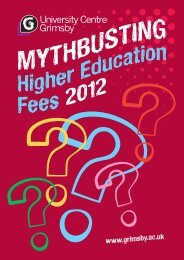Journal of Research & Scholarly Output 2006 - Grimsby Institute of ...
Journal of Research & Scholarly Output 2006 - Grimsby Institute of ...
Journal of Research & Scholarly Output 2006 - Grimsby Institute of ...
You also want an ePaper? Increase the reach of your titles
YUMPU automatically turns print PDFs into web optimized ePapers that Google loves.
<strong>of</strong> different mother tongues learning<br />
different target languages in formal settings”<br />
(Corder: 77). In the Chinese learning<br />
situation, we would probably place our<br />
learners on the other end <strong>of</strong> the scale: they<br />
are adult, learning English for academic<br />
purposes, and have highly formal<br />
instructional settings. So much can be<br />
expected <strong>of</strong> the features that are unique to<br />
the Chinese learners <strong>of</strong> English. And we can<br />
base most <strong>of</strong> our interpretations <strong>of</strong> their<br />
sentences on the mother tongue translation,<br />
as it is the case in actuality.<br />
interpretations in locating the possible<br />
sources <strong>of</strong> the learners’ errors, steady<br />
progress could be made when the<br />
methodology is improved and variables are<br />
held in control.<br />
Conclusion<br />
As the learner’s language is systematic and<br />
describable, error analysis provides access<br />
to the observable data from which<br />
inferences can be made about the learner’s<br />
underlying knowledge about his or her<br />
language. As a methodology error analysis<br />
has implications both for practical purposes<br />
and psycholinguistic orientation. It serves to<br />
help the teacher to gain insight into the<br />
learner’s learning process and provide more<br />
facilitative conditions that can promote the<br />
process. Mere error correction, particularly<br />
the immediate correction in class, may<br />
distort the learner’s hypothesis formulation<br />
and delay the learning process. More solid<br />
evidence could be obtained when the data<br />
is elicited from a large corpus <strong>of</strong> the textual<br />
materials, in which irrelevant performance<br />
mistakes can be more easily deleted on the<br />
basis <strong>of</strong> probability method and regularity<br />
can be more easily captured. Moreover, the<br />
corpus can be enhanced by integrating<br />
materials from the learner’s oral production<br />
for evidence <strong>of</strong> spontaneous speech. Even<br />
though caution has to be made about our<br />
References:<br />
Ausubel, David A. (1963). Cognitive<br />
structure and the facilitation <strong>of</strong> meaningful<br />
verbal learning. <strong>Journal</strong> <strong>of</strong> Teacher<br />
Education 14:217-21<br />
Corder, S. Pit. (1981). Error Analysis and<br />
Interlanguage. Oxford: Oxford University<br />
Press.<br />
Selinker,1972. "Interlanguage". International<br />
Review <strong>of</strong> Applied Lingustics 10 Corder,<br />
S. Pit.(1973). Introducing Applied<br />
Linguistics, Penguin: Educational<br />
FOCUS Page Page 93



